|
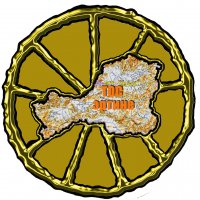 This summer, Tuvan journalists had the fortuate opportunity to meet the living treasure of Tuva - the snow leopard. On July 21-23, the WWF organized a press- tour for journalists of GTRK “Tuva”, TK “Novyi Vek”, and journal “Plyus Inform” to visit the camp of the expedition as part of the learge-scale Tuvan project “Tos Ertine” - “Nine Treasures”. This summer, Tuvan journalists had the fortuate opportunity to meet the living treasure of Tuva - the snow leopard. On July 21-23, the WWF organized a press- tour for journalists of GTRK “Tuva”, TK “Novyi Vek”, and journal “Plyus Inform” to visit the camp of the expedition as part of the learge-scale Tuvan project “Tos Ertine” - “Nine Treasures”.
The journalists spent three days in Mongun-Taiga district, so that they could personally experience how the snow leopards live and survive in places which were once their hunting range, and now they are settled by people.
They found out how the poachers capture leopard cubs to sell to private zoos of rich people. How, being squeezed out from their natural places by decreased availability of food - wild hoofed animals, the irbis is forced to attack domestic livestock, for which he is subjected to persecution by herdsmen.
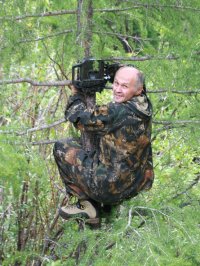 The visit to snow leopards was annexed to the work in Mongun-Taiga by the expedition of RAN - Severtsev Institute of evolution. The work was made possible in the framework of the program of study of snow leopards on the territory of Russian Federation with support of the government of RF. The scientists have been working here since June, and every day they carefully set up and check their photo-traps. Their goal is to try out new methods of study of the groupings of irbis on Tuvan territory: setting up photo-traps, analysis of genetic material, and satellite monitoring. The visit to snow leopards was annexed to the work in Mongun-Taiga by the expedition of RAN - Severtsev Institute of evolution. The work was made possible in the framework of the program of study of snow leopards on the territory of Russian Federation with support of the government of RF. The scientists have been working here since June, and every day they carefully set up and check their photo-traps. Their goal is to try out new methods of study of the groupings of irbis on Tuvan territory: setting up photo-traps, analysis of genetic material, and satellite monitoring.
The group of journalists with the staff members of “Ubsunur depression” nature preserve and WWF leaves Kyzyl early in the morning. The journey is not short, and is difficult. As the UAZ approaches Mongun-Taiga, the lively conversation imperceptibly fades into silence.
“Mongun-Taiga just suddenly loomed over me, - exclaims Tatiana Ramazanova, journalist from “Plyus Inform”. - The landscape changed so smoothly, gradually. And suddenly Mongun-Taiga just loomed…”.
Snowy mountaintops in the distance, narrow stony road, squeezed between to hills, stone scree on the slopes. The size of the mountains emphasizes the rough severity of the locality. Trees, tormented by by winds and cold are scrawny and short. Even ivan-chai, which stretches its pink branches as tall as a human being in the valleys, here is no taller than a dandelion. In winter, temperatures in Mongun-Taiga fall below -40 degrees centigrade. The winds can push even legendary giants off their feet. The snow covers the mountains as soon as October, and in some places it stays through the summer.
In these rough, remote high mountains it is still possible to meet surviving snow leopards. They have no equal in endurance or strength. Only the bravest, most courageous and the strongest people are given the honor of carrying its name!
Tuvans have worshipped and respected the “Master of the mountains” since time immemorial, ascribing supernatural abilities to him. The image of the snow leopard is present in epics and legends of Tuvan people, in stories and songs; images of irbis as decorative art were found in the famous ancient kurgans on territory of Republic Tuva. Scythian images of irbis are often associated with hunt scenes. That is evidence that the status of irbis is no less than that of “Tsar of animals” of Tuvan high mountain ranges. To this day the people of Tuva believe that to meet an irbis is an omen of some significant event that will play a special role in the life of this person or his family. Irbis attacks on livestock were (and still are, by some people) viewed by herdsmen as a punishment from above for transgressions of ancient laws of life in harmony with nature. To this time, the residents of the remote Sengilen mountains in the south-east of Tuva identifi the irbis as “Spirit of the mountains”, and are afraid to kill one of these animals, who are able to wreak vengeance on their killer even after death, destroying their cattle and their family.
Alexander Kuksin, employee of “Ubsunur depression” preserve, who was brought in by WWF as an expert, tells us about his meeting with a snow leopard in a mysterious, hypnotic voice. These stories present rich material for dreaming for those who wish to see a snow leopard in the wild. Alexander is the only person, who in the March of this year managed to photograph a snow leopard with a camera.
“This photo did not come easy, - says Alexander Kuksin. - In the spring, we were working with our Mongolian colleagues on the Tsagaan-Shibetu ridge, and as part of monitoring we were conducting a census of the irbis, collecting genetic material. In the morning we found a victim of irbises - a sarlyk (Tuvan yak), surrounded by footprints of no fewer than three individuals. We followed these footprints, we tracked the animals through snow and ice. One of our Mongolian colleagues almost perished, falling into an icy ravine. Then suddenly we saw the snow leopards - a female with two kittens, as they cautiously peered at us from behind rocks. I photographed them, after which they disappeared just as unexpectedly as they appeared…”
The scientists’ camp welcomes us with rain. Mongun-Taiga watchfully admits the aliens into its holy of holies - the irbis country. Our place of dislocation for the next two days will be a canyon between two mountain ridges, in a valley of a tiny cold mountain stream. Scree underfoot, a sea of flowers and small trees complete the majestic picture. And orange tents - bright spots like gigantic embers.
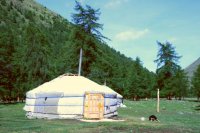 “Yes, yes, already for the second day there is the feeling as if somebody was watching you, - laughs the expedition member Jose Ernandes-Blanco, as he notices the cameraman of “Novyi vek”, Volodya Dongak, turn around yet again and attentively look up to the tops of the ridges between which the camp is squeezed. - Here we are planning to find the irbis, and this very moment he may be observing us from the mountaintops, laughing - “what idiots”. “Yes, yes, already for the second day there is the feeling as if somebody was watching you, - laughs the expedition member Jose Ernandes-Blanco, as he notices the cameraman of “Novyi vek”, Volodya Dongak, turn around yet again and attentively look up to the tops of the ridges between which the camp is squeezed. - Here we are planning to find the irbis, and this very moment he may be observing us from the mountaintops, laughing - “what idiots”.
“According to expert evaluation, today about 15 snow leopards live on the Tsagaan-Shibetu ridge, and on Shapshal ridge about 20 individuals, - Kuksin explains. - Until the beginning of 20th century, the range of the irbis was quite large, and the density of their population was sufficient. The demand for snow leopard pelts started growing as trade developed, exchange with other states and within Russia. It was believed, and among people of Central Asia it still is, that owner of a snow leopard pelt must be a brave and skillful hunter. And wherever there is demand, supply will appear - the fashion of having carpets of snow leopard pelts as well as the leopards themselves, has done its job. The numbers of the irbis started to decrease.”
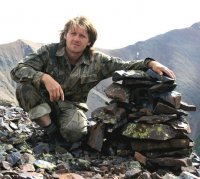 The rain quiets down and surprisingly the sun peeks out. “What can you do, this is a sharply continental climate”, somebody said. “Nasty continental climate”, somebody else added. The rain quiets down and surprisingly the sun peeks out. “What can you do, this is a sharply continental climate”, somebody said. “Nasty continental climate”, somebody else added.
The entire delegation then took off to the nearest place with a photo-trap. One kilometer through a rocky canyon and along a disintegrating bank of a mountain stream gives us an idea about the daily trek of the scientists, who go to check the photo-traps, so that afterwards, getting back to the “headquarters tent”, they turn on the computer and, with bated breath, search endless succession of snapshots made by the cameras… Here’s grass, bushes, more grass, ground squirrel, a sable, marmot, butterfly, bird… And there it is, success!
Every member of the expedition thinks about this in his heart: “Oh, if only we had put the trap just a little bit lower, we would have gotten a great picture of the irbis. He walked right up to it, the camera was working just fine, but we have aimed it too high, and the sky came out really well, - remembers Poyarkov.
Today, more than 40 photo-traps are set up on Tsagaan-Shibetu ridge. The very first sharp image of the irbis was photographed by the REKONIKS camera right on the day the journalists arrived in the camp.
“Well, isn’t it symbolic, - Tatiana Ivanitskaya, the WWF press-secretary said, - The animal decided to show himself specially to us!”
The photo is in grayish fog, but a distinct silhouette of a snow leopard can be seen in right profile, the irbis moving along the path in early dusk.
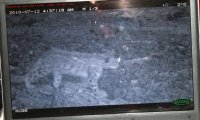 It is not the first photo since the start of this expedition, but the other images were not at all suitable for scientific analysis. It seemed the irbis has been playing with the people. Curious just like all cats, the irbises show interest in the cameras, sneak up on them from the rear, sniff them, in such a way that the photos consist of separate unfocused body parts of the predator. It is not the first photo since the start of this expedition, but the other images were not at all suitable for scientific analysis. It seemed the irbis has been playing with the people. Curious just like all cats, the irbises show interest in the cameras, sneak up on them from the rear, sniff them, in such a way that the photos consist of separate unfocused body parts of the predator.
Today, Republic Tuva is one of very few corners of the world where it is still possible to see the snow leopard. The greatest portion of the range of this predator in Russia is precisely here.
The Mongun-Taiga and Bai-Taiga kozhuuns is the true Snow Leopard Country, where the local herdsmen can meet irbis and also tell about eye-to-eye meetings with the predator people and irbis live here side by side and try not to interfere with each other.
“This is a leopard nursery, - smiles the head of Mongun-Taiga district, Ochur-ool Alexei Oorzhakovich. - Of course we know that such rare animals live here, and we understand that they need to be protected.”
Nevertheless, cases of poaching are known, even though they are carefully covered up. In the high mountainous districts of Tuva, where people survive by livestock herding, there is a conflict of interest between the herders and the irbis. The conflict originated when local herders started grazing their cattle in the areas inhabited by this rare predator, and at the same time the population of wild hoofed animals (the main natural prey of the irbis) was sharply reduced by poaching. Being deprived of its natural prey, snow leopards started attacking cattle. The leopards attack sheep and goats, more rarely the large domestic animals - yaks and horses, mostly young individuals. however there was a case of a female irbis with two kittens having killed a massive eight-year-old yak.
According to WWF data, in the spring of 2010 on the Tsagaan-Shibetu range, during the period from November 2009 to February 2010, 6 cases of leopard attacks on domestic cattle were documented. Especially large losses of sheep and goats - up to 80-90% of total number of perished animals - occur when an irbis gets into a koshara ( roofed enclosure for sheep). When an irbis gets inside a koshara through a ventilation opening, the irbis becomes crazed 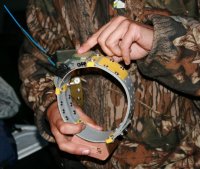 either by the sheer amount of available food or from just plain excitement, and kills and injures a huge number of livestock trapped in the koshara with him; then it sometimes happens that, after eating his full, the irbis cannot jump back outside. Herdsmen coming into the koshara then may become eyewitnesses to the slaughter, and stand face to face with the snow leopard, as he is trying to sneak out through the open door. There were cases when the herdsmen would shoot the leopard in vengeance for such an attack, or track the animal and kill it, or attack it an stab it to death right in the koshara with pitchforks. either by the sheer amount of available food or from just plain excitement, and kills and injures a huge number of livestock trapped in the koshara with him; then it sometimes happens that, after eating his full, the irbis cannot jump back outside. Herdsmen coming into the koshara then may become eyewitnesses to the slaughter, and stand face to face with the snow leopard, as he is trying to sneak out through the open door. There were cases when the herdsmen would shoot the leopard in vengeance for such an attack, or track the animal and kill it, or attack it an stab it to death right in the koshara with pitchforks.
“Irbis attacks domestic livestock, - Alexander Kuksin continues. - We explain to people why this happens: “They attack because now there are few arkhars, wild goats, other wild hoofed mammals, which are being killed off illegally, out of control, and then there is nothing much left for the irbis. The pressure created by poaching has reached immense dimensions. Some herders understand this and say - it is our own fault.”
“To protect the cattle and to avoid the killings, a simple but effective method has been worked out. With the support of the PROON GEF project by organization “Art”, and with the staff of the “Uvsunur depression” nature preserve, the ventilation openings of kosharas in Mongun-Taiga and Bai-Taiga have been reinforced with simple wire netting, which successfully prevents irbis incursions into the enclosures. We published an accessible and comprehensible brochure telling the herdsmen about this simple and effective method. In two years there has not been a single case of an irbis entering a koshara.
Now it only remains to solve the problem of irbis attacks on cattle in open pastures. So far this has not been easy. People have to understand that, living side by side with the irbis, they have to delimit their pastures.”
All that is left in Tuva is to get a video film of irbis. The cameramen pensively look into the distance and promise to think about returning here in the fall and winter for photo or video hunt.
Thank you, Mongun-Taiga! Thank you for opening up at least some of your secrets, that you did not drench us with rains and frozen us with cold winds, and instead you gave us a chance to touch your holy places, to learn at least a few secrets of your immense treasury, and permitted us to generate in our hearts eternal love for your ridges, snow-white mountains, cold mountain rivers, steadfast forests, and especially - to the invisible and mysterious “spirit of Tuvan mountains” - the snow leopard.
We return home.
Already as we are leaving Kyzyl, the militia on duty decide to search an immense backpack carried by a young girl who is going to Krasnoyarsk. “That was us who went to Mongun-Taiga, to visit the snow leopard, to see how they study it, - Tatiana Ivanitskaya, the WWF press secretary explains. The officer on duty becomes animated. “Yes, and how? How interesting! Do you know, here in Tuva we believe that whoever sees a leopard will be extremely fortunate, - he says thoughtfully. - Do you know, some drivers coming through here told me that they saw a snow leopard crossing the road right at Buyba, they almost ran him over!” . “You have an interesting job, - he adds, gesturing that it is OK to stop ravaging that backpack. - Have a good trip!”
|
|
